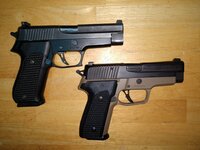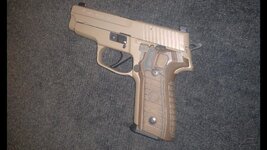- Messages
- 145
- Reactions
- 169
I love all my sig pistols. Have many different models. Haven't run into one yet that isn't accurate or reliable. Great guns... Go for it!
Follow along with the video below to see how to install our site as a web app on your home screen.
Note: This feature may not be available in some browsers.
My understanding is, that like many other manufacturers, SIG produces guns and/or at least some gun parts, in the USA to get around US gun laws on importing guns, and to be able to sell US made guns to LEOs and the military.
I have SIGs that say made in Exeter, NH and some that say made in W. Germany on certain parts. I see no real difference in the quality of either. YMMV, but I like all of my SIGs.
As my M11-A1 is clearly marked P228, and as explained to me, a P228 frame and internals with a P229 machined slide, what is your "expert" description of the difference between a P228 M11-A1 and a P229 M11-A1?Except it's not a 228; it's a 229 with m11a1 on the slide to dupe people who don't know any better. 228 is a whole different gun and handles much different. Got 2 west Germans sitting in my gun room. Probably the best pistol sig ever made, if you ignore the origins 210s
Its almost janky as the P225 releases that go for $1000 and are every way shape and form inferior to the surplus P6 that they are copying that go for $400.
As my M11-A1 is clearly marked P228, and as explained to me, a P228 frame and internals with a P229 machined slide, what is your "expert" description of the difference between a P228 M11-A1 and a P229 M11-A1?



Neat-o.Its hilarious when people spout anecdotal evidence and their once offs, ignoring the complete body of work and a massive same size.
Ask any Respected gunsmith or Gun guru who has been balls deep in this game for 20+ years and they will tell you exactly what I will.
The exception doesn't make the rule. If 60% of the guns they make are good to go, that just means you were either Lucky, don't shoot enough to notice or aren't in tune with your equipment to know the difference.
There is a reason gun collectors don't buy US sigs, for the same reason Kimber is considered trash in the 1911 world. Go over to 10-8 forums and maybe you will learn something from people who actually know what they are talking about.
This is the problem with the gun community. Its no different than society with over half of the population being on the left side of the bell curve. Everyone thinks their opinion is equal, when its not. Its like some high school kid arguing with someone with a PHD is in the subject matter.
Sig has used the same template for 20 Years:
Rush a product to Market
Cut costs anywhere possible
Use their customers as beta testers
When the product inevitably is not salvageable, discounting it and stop supporting it.
New revisions and versions are purposely not backwards compatible so you have to buy all new accessories and mags.
Come out with 50 different versions of the same product. Name the same junk Scorpion , Legion or whatever and charge a premium for the SAME product.
Outsource parts to 3rd world countries who don't have indoor plumbing wherever possible.
Spend more money on marketing and paid reviews than actual R&D and customer support and warranty service (Just like Kimber)
228 is more compact and holds fewer rounds in 9 mm. By compact think in terms of comparing a standard 1911 to a commander/ officer model of 1911. 228 was used by a lot of government agencies for carry and concealment considerations rather than carrying full sized 229. Still, the 228 carries 13+1 in the chamber with flush mags in 9mm without giving too much up in accuracy and is mechanically just as dependable as full size 229
My guess is, if it were a true P229 frame it would handle multiple calibers and have the same measurements. That being said, I truly enjoy shooting mine and it fits the PNW weather.The 228 M11 is a 228.
The M11-A1 is a 229 with 228 grip panels.
The only thing they share in commonality is no rail. And the stupid 228 grip panels, which is the only thing that is interchangeable between them.
Different barrel, locking insert, slide, frame and internals not counting the phosphate coating.
I have a 228 slide that I can use on my M11-A1 and 229 Select but I have to use a P228 locking insert.
View attachment 689443
I run it with the SS slide though as it shoots much better and the 228 slide just sits around now.
View attachment 689444

My guess is, if it were a true P229 frame it would handle multiple calibers and have the same measurements. That being said, I truly enjoy shooting mine and it fits the PNW weather.